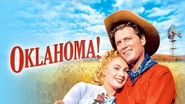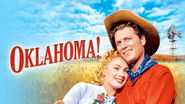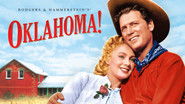fischelliot
Oklahoma! is the greatest musical ever filmed. You may have other personal favorites, but when R&H decided to produce the film version, they micromanaged their baby until it was perfect. They succeeded on all counts-acting, singing, timing, choreography, photography that blows you away. It also shows the darker side in what is seemingly a simple romantic story. Director Zinneman's choice to have threatening Rod Stieger as a counterpart to the sweet story, There is no argument that the songs are performed as the composers wanted, and McRae and Jones signing and performances are unequaled. The movie sets a high bar for any production to cross, and having seen many stage productions, none has the effect of the magnificent movie. I was fortunate enough to see the original release at the Egyptian in Hollywood, and the revival at the same theater 38 years later, both on the marvelous TODD-AO curved screen. Its more impressive on a big screen and I would gladly pay to see this on a large screen. The latest Blue-Ray version look and sounds absolutely beautiful, has impressive 7.1 DTS-HD sound and is a big improvement over the 2005 release which was pretty worn. Thank you 20th Century Fox for restoring this not only historic first Todd-AO film, but allow the firm to be shown as it was originally meant to be seen
Scott Hind
Oklahoma stands as the perfect example of how musical used to be. With les mis, phantom and Evita experimenting with the darker side of music and tone of morgen musicals, Oklahoma goes for the classic style of charming the audience with innocence. A method done to pure perfection. Let's take things one at a time.Gordon Macrae has one of the finest voices of any movie soundtrack. Fact. It maybe lacks the intensity of some singers, but it's something and Oklahoma is him at his finest. Shirley jones has a heavenly voice and plays the innocent character of Laurey very well, especially for a debut. The music, with some exceptions is strong throughout. It isn't epic like phantom, but each is played for humour and charm and is finely pulled off. The vocals with the exemption of a girl who can't say no are brilliant and the Kansas City number gives us a lovely dance number. (I will quickly add about the girl who can't say know it's played for humour and is very funny so the terrible vocals can be forgiven) This film also has wit. And a lot of it. It knows exactly how to be funny and will tickle your funny bone nearly every minute. It also has a lot of what I call anti-Wit. That's wit that comes from characters being stupid. There is nothing funnier that an idiot trying to use logic and Oklahoma uses this weapon in epic fashion I have to give a special mention to the peddler. Funniest character ever! For an actor to display such charm and likability to such a vile con man is a master class in acting but is often overlooked. Oklahoma has its problems. The ballet is too long and I've mentioned girl who can't say know. I personally like my musicals to be a little more complex and darker. But for a feel good film? For charm? Oklahoma. OK!
Leofwine_draca
There's little to dislike about this musical, which is a colourful and heart-felt western charting a double romance and set in a world of cowboys, cattle-ranchers and sinister ranch-hands. I found it very similar in look and tone to the similar SEVEN BRIDES FOR SEVEN BROTHERS (which has the edge, I think) with some scenes, such as the bust-up halfway through, virtually identical.The notable thing about OKLAHOMA! is that it really picks up in the second half. The first half is a little slow, with the viewer struggling to put the pieces together to work everything out. In the second half, everything starts slotting into place, and it all gets very traditional and entertaining.The song-and-dance numbers are fine, and the characters are all rather interesting. I found that the male leads weren't quite as memorable as the likes of Gene Kelly or Howard Keel in other musicals, but Gloria Grahame and Shirley Jones ably make up for this. Watch out for a fun little turn from Rod Steiger as the dastardly villain.
Steffi_P
This was the first of the stage-to-screen adaptation of a Rodgers and Hammerstein show, full of the sweetness, humour, rural idyll and dark touches that characterise their work. But rather than focus on the genius of that legendary composer-lyricist duo or the innovativeness of Oklahoma the stage show, I'm going to concentrate on how it is made to work for the screen, and what this production meant for the future of the screen musical.Rodgers and Hammerstein, not wishing to see a disservice done to their material, involved themselves considerably in the making of the picture, and this included selecting the director. To many amateur film buffs and fans of "serious" cinema, Fred Zinnemann may seem like an odd choice, and Oklahoma might appear to be an anomaly in his oeuvre, which is best known for its painstaking realism and heavy-going drama. Zinnemann was of course one of the most bankable directors of this period, having made a number of critical and commercial hits in the early 50s, including 1953's Best Picture Oscar winner From Here to Eternity. But I believe Rodgers and Hammerstein were being quite savvy when they made the choice, and not just blindly plumping for an industry favourite. Oklahoma makes the bold step which MGM, the current champions of the genre, rarely made, of being filmed on location. Few directors had a better feel for the beauty and serenity of the countryside than Zinnemann, so who better to smooth the transition from the enclosure of the stage to the vastness of the plains? Of course, directing a musical is a craft in itself which directors either have or they don't. Zinnemann had no experience in the genre, and while he doesn't have the same flair for complex visual orchestration of the undisputed master Vincente Minnelli, he shoots the numbers in his own sensitive style, which proves very effective for the gentleness of the Rodgers and Hammerstein world. For the relaxed, character-orientated songs like "Surrey with the Fringe on Top" he shows off the beauty of the location to match that of the music. He uses the extra width of the new scope ratio to add little bits of movement to the edges of the screen – a horse flicking its tail or a tree waving in the breeze – complementing the song without being intrusive enough to overshadow it. For "People Will Say We're in Love", there are natural-looking extras in the background whose movements are in time with the tune. With "Poor Jud is Daid", easily the funniest song, the whole thing is shot before a plain background, focusing us entirely on the words and the actors' expressions.For the more crowded dance numbers, most of the credit goes to choreographer Agnes de Mille. De Mille shows a rare sensitivity to every nuance of the music as well the nature of each character, and her influence on the overall look of this picture is so significant she almost deserves a co-director credit. Probably the greatest example of her work in Oklahoma is on the number "Many a New Day". If you listen carefully to the music, you can hear it has a lot of what are called counter rhythms, with often double-time melodies playing under the main tune. De Mille mimics this by having some of the dancers in double-time to the rest, and having each strand of the orchestration matched by a different dance step. It's a pity she didn't work more often in cinema, and also a shame the Oscar for Best Dance Direction had been discontinued. She certainly deserved some sort of award for her valuable input.At this time in musicals story and drama were beginning to take precedence over performance showcasing. It followed then that cast members were being chosen for their acting ability rather than their song-and-dance skills, although at this point it was still mainly the supporting roles that were filled by people who were actors first. Pick of the bunch here is surely Gloria Grahame. Grahame is patently tone-deaf, but she acts each of her songs more than she sings it, bringing the part to life through tone and movement. Besides, her tuneless wailing fits the character nicely. Then there's Eddie Albert as Ali Hakim. Albert probably knew he had the silliest and least convincing character of the whole show, so he just has fun with the role, playing the peddler like a cross between Alan Hale and Chico Marx. The oddest bit of casting is Rod Steiger, who plays Jud like he was still in On the Waterfront. But the gritty intensity of his performance really works, making the character seem like a real menace rather than a comedy figure you can just laugh off. And kudos to "serious" actor Steiger for putting time and attention into getting the part right. Steiger's appearance here represents the greatest departure for casting in musicals. Grahame or Albert could conceivably have appeared in an early 50s MGM musical, but Rod Steiger, never! And in fact, it is these delightful supporting players who really make Oklahoma. Gordon MacCrae and Shirley Jones, who we can assume were chosen for their looks and vocal talent, make for rather bland leads. While these two would do better stuff later on, the fact that they fail to carry the heart of this movie points to the way forward for the genre. It wouldn't be long before such roles would be filled by top dramatic performers like Deborah Kerr, Natalie Wood and Audrey Hepburn, their singing voices dubbed (usually by an uncredited Marni Nixon). For better or for worse, the future of the screen musical belonged to the actors.







